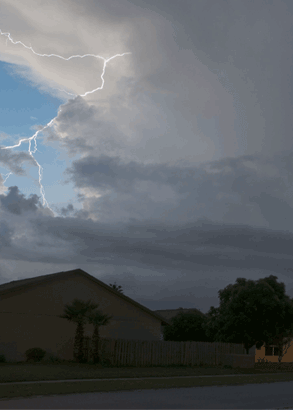

Last summer in Oromocto, two women were injured when a lightning bolt struck a tree they were walking past. A month later, a lightning strike killed 19 cows in a farmer’s field in Upper Hainesville, 50 km northwest of Fredericton. The losses were not covered by insurance.
 Richard Blais, chief compliance officer with WorkSafeNB said knowing what to do when lightning is close is especially important for people who work outdoors (for example, construction workers, road crews, landscapers and farm workers).
Richard Blais, chief compliance officer with WorkSafeNB said knowing what to do when lightning is close is especially important for people who work outdoors (for example, construction workers, road crews, landscapers and farm workers).
“Employers need to recognize the hazards associated with electrical storms. Where appropriate, safe procedures and work systems should be in place to minimize the risk of injury or harm to employees. These procedures should be reviewed seasonally.”
Lightning poses very serious hazards for outdoor workers – it is the most dangerous summer weather phenomenon and kills more people than hail, wind, rain and tornadoes combined. Lightning flashes approximately 2 million times a year in Canada, killing an average of 16 people and injuring up to 70.
According to Environment Canada, New Brunswick averages the highest number of days of thunderstorms a year in Atlantic Canada (10-20), with Edmundston topping the region’s list of lightning-prone cities. Since these are more frequent from June to August, New Brunswickers need to be especially vigilant at this time of year.
The organization says the safest place to be during a thunderstorm is indoors, or in a metal-roofed vehicle. But if you do find yourself outdoors, one of the best forms of protection from lightning is knowing and using the 30-30 rule. Once you see lightning, start counting until you hear the thunder. If there is less than 30 seconds between the lightning flash and the thunder, take shelter immediately. (Each second represents 300 metres. If you count less than 30, the storm is less than 10 km away, and there is a chance the next strike could be within 10 km.) Do not return outdoors until 30 minutes after the last lightning strike.
Lightning tends to strike higher ground and prominent objects, Blais added.
“Keep a safe distance from tall objects such as trees, flagpoles and telephone poles – ensure that you are not the tallest point. Also, move away from objects that conduct electricity, such as tractors, golf carts, golf clubs, metal fences, motorcycles, lawnmowers and bicycles.”
Feeling your hair stand on end may mean that lightning is about to strike. Immediately get in the frog position by crouching down on the balls of your feet, with feet together, arms around your knees and bend forward, covering your ears with your hands. Make yourself as small as possible while minimizing your contact with the ground. Do not lie flat!
If you find yourself outdoors in the open, try to take shelter in low-lying areas such as valleys or ditches, but watch for flooding if raining heavily. And if you are in a group in the open, spread out, keeping people several metres apart.
It’s important to stay away from water during a thunderstorm, even puddles. Lightning can strike water and travel some distance from its point of contact. If you are in a boat, head for shore immediately, but if caught on the water, crouch low in the boat.
While lightning poses the greatest hazard to those working outdoors, being indoors presents risks as well. Keep as many walls as possible between you and the outside. Avoid touching appliances that conduct electricity, such as radiators and sinks, and only use battery-operated appliances. And don’t take a shower or bath – if lightning strikes the plumbing system, it can be conducted into the tub or shower.
Lightning Myths
Myth: If it is not raining, there is no danger from lightning.
Fact: Lightning often strikes outside of heavy rain and may occur more than 16 km away from a storm. Use the 30-30 rule. If you count 30 seconds or less between lightning and thunder, seek shelter. Remain sheltered for 30 minutes after the last thunder.
Myth: Persons who have been struck by lightning carry an electrical charge.
Fact: Although someone struck by lightning receives an electrical shock they do not carry an electrical charge and can be safely handled. Victims may be suffering from burns or shock and should receive immediate medical attention. If breathing has stopped, mouth-to-mouth resuscitation should be administered. If breathing and pulse are absent, cardio-pulmonary resuscitation is required.
Myth: The rubber soles of shoes or boots or rubber tires on a car will protect you from being struck by lightning.
Fact: Rubber-soled shoes and rubber tires provide no protection from lightning. Lightning (striking between the cloud and the ground) has potentially travelled thousands of metres through thin air; rubber-soled footwear or tires are inconsequential. However, the metal shell of a car provides a pathway for the lightning strike to flow around the vehicle, provided the car has a hardtop metal roof (not a convertible). Although such vehicles do not offer absolute protection from lightning, you are much safer inside with your hands on your lap than outside during lightning.
Myth: Lightning never strikes twice.
Fact: The Empire State Building in New York City has been struck as frequently as 15 times in 15 minutes, and is struck 22-100 times a year.
Myth: Cellphones attract lightning.
Fact: Although cellphones do not attract lightning, you should not use them outside during a thunderstorm because of how it could harmfully change the current directed through the body if struck by lightning while using one.
Read our Hazard Alert: Environmental conditions create unsafe working situations.